They say… 
Best beer and travel writing award 2015, 2011 -- British Guild of Beer Writers Awards
Accredited Beer Sommelier
Writer of "Probably the best book about beer in London" - Londonist
"A necessity if you're a beer geek travelling to London town" - Beer Advocate
"A joy to read" - Roger Protz
"Very authoritative" - Tim Webb.
"One of the top beer writers in the UK" - Mark Dredge.
"A beer guru" - Popbitch.

|
London’s Best Beer, Pubs and Bars updates
Central London – Holborn and Legal London
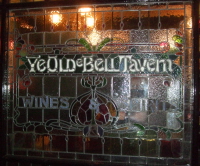 Old Bell Tavern, London EC4 Traditional pub (Nicholson’s/Mitchells & Butlers)
95 Fleet Street EC4Y 1DH
T (020) 7583 0216 W www.nicholsonspubs.co.uk/theoldbelltavernfleetstreetlondon
Open 1000 (1200 Sat)-2330 (1800 Sat, closed Sun). Children welcome until early evening, with children’s menu.
Cask beer 7 (Fuller’s, Sharp’s, St Austell, unusual guests) Cask Marque, Other beer 2 bottles, Also Some wines
Food Nicholson’s breakfast and pub grub menu, Wifi.
One of Nicholson’s smaller pubs, but handily placed at the City end of Fleet Street, the Old Bell claims a license dating back 300 years. It also claims it was designed by Christopher Wren and once housed the stonemasons that accomplished his building projects after the Great Fire of 1666, but I suspect what you see today is much rebuilt. The front section of the pub, with its flagstone floor, is clearly distinct from the floorboarded rear with its open fire, backing up the claim that the main part of the building was originally set back from the street in its own court, and there’s a rear exit onto an intriguing back alley. You’ll also spot the remains of a Victorian partition. Seven pumps dispense the chain’s standard London Pride, Doom Bar and Tribute plus guests that explore the more exotic reaches of Nicholson’s seasonal guest lists — perhaps Downton, Oakleaf, Moor or RCH. An eighth pump has real cider. A pleasant retreat.
National Rail City Thameslink Underground Chancery Lane, St Pauls River Blackfriars Cycling NCN4, LCN+7 Walking Jubilee Walkway, link to Thames Path
London’s Best Beer, Pubs and Bars updates
West London: Hammersmith and Fulham
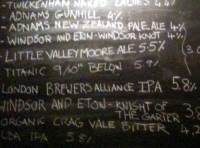 Choices at the Duchess of Cambridge, London W6 Contemporary pub, brewpub (Independent)
320 Goldhawk Road W6 0XF
T (020) 8834 7336 W www.theduchessofcambridgepub.com f theduchesspubw6 tw duchesspubw6
Open 1200 (1100 Sat)-2300 (2400 Fri-Sat, 2230 Sun). Children welcome until 2000.
Cask beers 13 (Own beer when brewery commissioned, unusual often local guests), Other beers 55 bottles, Also 11 real ciders, wines, specialist spirits
Food Upmarket pub grub, Outdoors Side terrace, Wifi. No disabled toilet but flat access.
Tue quiz, Fri live music, seasonal parties, functions
The latest venture from the owners of one of my Top 25, the Bree Louise specialist real ale and cider pub near Euston, the Duchess is a big and previously unloved roadside pub on a main junction of the route between Shepherds Bush and Chiswick, just on the edge of Hammersmith right by leafy Ravenscourt Park. It was once known as the Brook but has been renamed to commemorate a certain new member of the royal family — only the second pub in the country to take the name — and is being managed by two former Mitchells and Butlers staff, Ruth Boult and Simon Waind. Behind the imposing frontage with its attractive wooden side terrace there’s an extensive single drinking area refurbished along clean and contemporary lines, notably more upmarket than its sister pub, with red and white paint, heavy wood tables, dark brown chairs, beer advertising enamels, a welcoming open fire and the remains of a decorated ceiling.
Like the Bree, much of the beer is served from the cask by gravity — there’s a stillage with an impressive hoist above, dispensing up to nine ever changing beers, plus four on handpump, often from small and local producers. Windsor & Eton and Redemption regularly feature, alongside perhaps Crag Vale, Little Valley or Titanic from further afield and there are usually dark beers and unusual styles. Things will get even more local in January 2012 when the pub opens its own in-house brewery. And unlike the Bree, the draught choices are supplemented by over 50 bottles of world beer classics including Anker Gouden Carolus, several British craft lagers from Calvors, Goose Island 312 wheat beer, Nils Oscar God Lager and Westmalle Tripel. An impressive range of real ciders, around 25 wines by the glass and more by the bottle, and a back bar crowded with single malts, tequilas and other specialist spirits including gin and vodka from local craft distillery Sipsmith vastly extend the drinks offer. Suitably British food ranges from tasting plates of artisanal cheeses, sausage snack platters and Welsh rarebit to reasonably priced steaks, burgers, fish and chips and roast butternut squash.
It’s a bigger and more ambitious project than the Bree, and on a site less favoured than its sister’s central location, but if you’re not local it’s well worth making the trip. Alot of effort has gone into creating a very special and remarkable pub that deserves to flourish.
Underground Stamford Brook Bus Flanchford Road (94 Turnham Green, Shepherds Bush), Stamford Brook Road (237 Gunnersbury, Shepherds Bush) Cycling LCN+ 35
London’s Best Beer, Pubs and Bars updates
Southwest London: Kingston
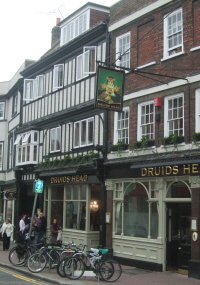 Druid's Head, Kingston upon Thames KT1 (London) Contemporary pub (Greene King)
2 Market Place, Kingston KT1 1JT
T (020) 8546 0723 W gkpubs.co.uk/pubs-in-kingston-upon-thames/druids-head-pub
Open 1100-2300 (2400 Thu-Sat).
Cask beers 6 (Greene King, guests), Other beers 2 keg, 1 bottle, Also 30 wines
Food Varied enhanced pub grub, Outdoors Beer garden, upstairs sun terrrace, Wifi. Disabled toilet.
Occasional seasonal events, functions, conference room.
Former coaching inn the Druids Head claims to be the oldest pub in Kingston — the sprawling Grade II*listed building, in a prime position on the market place, is partly 17th century, though it’s been much rebuilt and the frontage is largely Victorian. Inside is bigger than expected, with a long and deep ground floor area broken into several spaces, and a similarly sized first floor with some pleasant hidden corners, while both a beer garden and an upstairs sun terrace facilitate outdoor drinking. Exposed brick and beams, a massive staircase and 18th century moulded plaster ceilings add to the heritage feel, though a recent makeover has left it a thoroughly modern pub, comfortable if rather corporate.
Greene King pubs don’t figure too prominently in the guide as until now their beer choice has tended to be limited and their key brands are readily available elsewhere. But even GK are noticing the growing interest in speciality beer and this is one of the pubs expanding its range in response. Besides the brewery’s own brands — the ubiquitous IPA, a pump rotating Abbot and Ruddles County, and a changing range of other GK brands (including Belhaven)) and seasonals — you might find guests from the likes of Batemans (the excellent Salem Porter when I called), Black Sheep or Hyde’s. Staropramen and Blue Moon are on keg while Budvar is in bottles. A lengthy menu stretches from haggis and macaroni bites to hunter’s chicken, beef and Abbot pie and sweet potato, apricot and chick pea kebabs.
Insider tip. The snug at the front right not only has Victorian wood panelling, it’s also free of piped music.
National Rail Kingston Cycling NCN4, LCN+ 33 75 Walking Thames Path, Thames Down Link, links to Richmond Park paths
London’s Best Beer, Pubs and Bars updates
Central London: Soho and Leicester Square
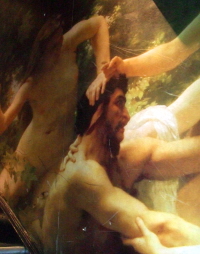 Murals at the Crown and Two Chairmen, London W1 Contemporary pub (Castle/Mitchells & Butlers)
31 Dean Street W1D 8SB
T (020) 7437 8192 W www.thecrownandtwochairmenw1.co.uk f thecrownandtwochairmen
Open 1200-2330 (2400 Fri-Sat, 2230 Sun). Children welcome daytimes.
Cask beers 5 (Purity, Sharp’s, 3 sometimes local guests) Cask Marque, Other beers 7 keg (international), 10 bottles Also 40 wines, a few cocktails
Food Imaginative pub grub, Outdoors A few tables on street, Wifi.
Sun film club, Mon pub quiz.
This Soho stalwart has been through several different incarnations in the past few decades, attached to one pub chain or another. It’s now designated a Castle pub by owners Mitchells & Butlers, intended to be individualistic and quirky — thus the exterior purple paint job — in contrast to the more traditional Nicholson’s treatment currently applied to most M&B pubs in the area. This last makeover, in 2006, proved controversial with regulars at the time but doesn’t seem to have done trade any harm: the pub heaves even on evenings early in the week with a generally youthful Soho creative crowd. It’s also brought a much improved beer offer. Regulars Pure Ubu and Doom Bar were supplemented when I called with a trio of decidedly LocAle guests from Itchen Valley, W&J King and Sambrook’s, with Camden Town Hells on keg alongside the likes of BrewDog, Brooklyn, Sierra Nevada and Veltins. The kitchen reaches gingerly into gastro territory with dishes like ox cheek in red wine at relatively substantial prices, and in the daytimes there’s table service upstairs: enjoy the murals on the way up. Staff are trendy and friendly; furnishings are fairly basic, leaving room for the boisterous atmosphere.
Pub trivia. The curious name might suggest an inadvisable way to run a meeting, but as the sign indicates, the chairmen in question were more likely carriers of sedan chairs, a favoured form of transport for the wealthy in the days when London was still small enough for it to be practical. Queen Anne (reigned 1665-1714) is said to have sat for her portrait at James Thornhill’s studio opposite while her transport staff enjoyed a drink in the pub.
Underground Tottenham Court Road, Leicester Square Cycling LCN+ 39 6 6A Walking Link to Jubilee Walkway
London’s Best Beer, Pubs and Bars updates
Central London: Soho and Leicester Square
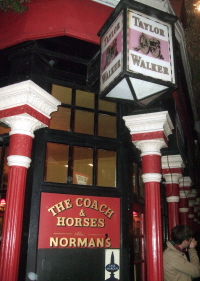 Coach and Horses, London W1 Traditional pub (Fuller’s lease)
29 Greek Street W1F 7HG
T (020) 7437 5920 W www.coachandhorsessoho.co.uk
Open 1100 (1200 Sun) – 2300 (2230 Sun).
Cask beers 4 (3 Fuller’s, 1 guest) Cask Marque, Other beers 2 keg, 2 bottles, Also A few wines
Food Enhanced pub grub. Wifi.
Wed/Sat piano singalongs
The Coach and Horses’ claim to be the West End’s most famous pub may be contestable, but it’s certainly one of London’s most legendary boozers, deeply embedded in Soho’s literary and disreputable heritage. It’s celebrated for its associations with satirical magazine Private Eye and for attracting the arty and painterly crowd that migrated south from Fitzrovia in the 1950s. For 62 years until 2006 it was run by Norman Balon, who revelled in the title of ‘London’s rudest landlord’, a skill deployed in wrangling a customer base of hard drinking characters including Francis Bacon, Peter O’Toole, Tom Baker, George Melly and Lucien Freud. Their patron saint was the self-destructive Spectator columnist and veteran regular Jeffrey Bernard (1932-97), famously portrayed by O’Toole in the late 1980s in Keith Waterhouse’s play Jeffrey Bernard is Unwell, after the euphemism the magazine used when the old soak was too drunk or hung over to file his copy. Memorabilia of the play, of Bernard himself and of many more aspects of the pub’s past are displayed on the walls, including clippings of Private Eye strip ‘The Regulars’ which was inspired by the pub, its landlord and customers.
Since Norman’s departure thankfully no-one has sought to shoulder his reputation and the Coach has become a less intimidating place: there are now piano singalongs and decent food from a short menu that includes some interesting veggie options, the sort of frippery that might once have provoked the landlord’s ire. But little has changed in appearance: the well-worn floor, dark red walls and wood panelling, still seemingly coated in tar all these years after the smoking ban, don’t appear to have been refitted since the early 1960s. Vestiges of branding from its days as an Ind Coope pub remain, like a lightbox above the bar advertising Double Diamond and the Taylor Walker lantern outside, dating from the first revival of the name of the long defunct East End brewery in the 1980s (it’s recently been revived again as one of pubco Spirit’s pub brands). The main drinking area is a medium sized single bar retaining elements of its old partitioning. There’s an upstairs room, too, where Eye fortnightly editorial meetings are still held, accessible only from behind the bar and now marketed during the day as ‘Soho’s Secret Tea Room’.
Fuller’s bought the pub in 2011 but the leaseholders who took over from Norman are still in place and are certainly not running it as a branded Fuller’s house. Three of the brewery’s beers are now on sale, though, including Chiswick Bitter, rare in the West End, alongside Gale’s Seafarer’s and London Pride. The fourth guest pump can get quite exotic — a St Peter’s green hop beer when I called. Bottled Pride and bargain priced Vintage Ale are in the fridge and Leffe and Staropramen widen the keg choices.
National Rail Charing Cross Underground Leicester Square, Tottenham Court Road, Covent Garden Cycling LCN+ 39 6 6A Walking Jubilee Walkway
London’s Best Beer, Pubs and Bars updates
Central London: Soho and Leicester Square
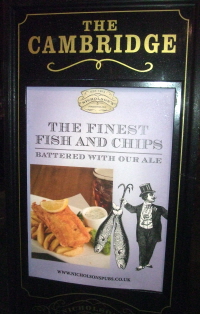 The Cambridge, London WC2 Traditional pub (Nicholson’s/M&B)
93 Charing Cross Road WC2H 0DP
T (020) 7494 0338 W www.nicholsonspubs.co.uk/thecambridgecambridgecircuslondon
Open 1000-2300 (2230 Sun). Children welcome daytimes upstairs if dining.
Cask beers 7 (Fuller’s, Sharp’s, St Austell, Nicholson’s guests) Cask Marque, Other beers 2 keg, 6 bottles, Also Some wines
Food Nicholson’s pub grub.
This Nicholson’s pub, perfectly placed right on Cambridge Circus adjacent to the Palace Theatre and McMullen’s pub the Spice of Life (p109), is small enough to achieve an intimate, local feel despite the bustling surroundings, with high copper-topped tables and a few more conventional tables and chairs in its single bar. It’s also one of the chain’s better beer stockists in central London, earning it a Good Beer Guide listing. Beside’s the standard trio of London Pride, Doom Bar and Tribute, the four guest pumps explore the more exotic reaches of the chain’s seasonal range: beers from Moor, Oakleaf, Quartz and Thornbridge when I visited. The last’s popular Jaipur regularly recurs. Kozel and Suffolk Blonde are quality lager choices while a smattering of bottled options includes Duvel and Sierra Nevada Pale. The menu, available in the pub or a small, cosy restaurant area upstairs, is a little shorter than in some pubs in the chain, including options like roasted vegetable tart and tiger prawn and chorizo pasta besides fish and chips, fishcakes, burgers and steaks. A useful bolthole in the heart of the West End.
Pub trivia. The pub was built in 1887 on the site of an older pub known as the Kings Arms. Most of its original features are now gone, but look up to find a splendid tiled ceiling in striking yellow and green.
National Rail Charing Cross Underground Leicester Square, Tottenham Court Road, Covent Garden Cycling LCN+ 39 6 6A Walking Jubilee Walkway
London’s Best Beer, Pubs and Bars updates
Southwest London: Richmond and Kew
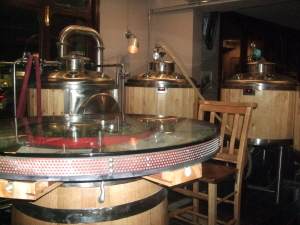 Brewhouse at the Botanist, Richmond TW9 (London) Contemporary pub, brewpub (Convivial)
1 Kew Green, Richmond TW9 3AA
T (020) 8948 4838 W www.thebotanistkew.com f The-Botanist-Brewery-Kitchen-Convivial-London-Pubs tw _TheBotanistkew
Open 1100-2300. Children welcome until 2000, later if eating.
Cask beers 6-7 (Botanist, occasional guests) Cask Marque, Other beers 1 keg (Meantime), 30+ bottles Also Around 30 wines
Food Enhanced pub grub/gastro menu, Outdoor Front terrace, beer garden, Wifi. Disabled toilet.
Wed quiz, Thu beer tasting & retro vinyl, Sat acoustic music, food promos, bookable “Brewer’s Breakfasts” with tastings.
Kew Green is an extensive green space just on the other side of Kew Bridge, unfortunately now bisected by the busy bridge approach road but still achieving that picturesqueness that seems to come so easily to London’s historic urban “villages”. It is centred on the 18th century St Anne’s Church with its Royal connections to nearby Kew Palace, is overlooked by fine houses of similar vintage and even hosts cricket matches in summer. The Botanist’s name is an obvious reference to the proximity of one of London’s premier attractions, the Royal Horticultural Society’s world famous Kew Gardens.
This family friendly pub doesn’t enjoy the most favoured spot on the green — it’s on a busy corner by the traffic — but is nonetheless well-placed in one of London’s most desirable residential areas, and the big windows provide great people watchng. The interior rejects traditional rustic decor for a slightly self-conscious contemporary feel, with a mix of furniture sprawling over several spaces, some tucked away cubby holes and a restaurant area off to the side. Of special interest to beer lovers is the attractive wood-clad brewhouse that since September 2011 has taken pride of place right by the large bar, with sacks of Bairds malt also clearly visible in the adjacent grain store.
The house beers, brewed by manager Mark Wainwright, have proved so successful that pubco Convivial is planning to repeat the initiative in one of its other pubs. Up to seven might be available at any one time, all cask, with the occasional guests from local brewers like Twickenham. Meantime London Lager is on keg, and there’s a strong bottled list too: classics like Duvel, Früh Kölsch and König Ludwig Weissbier, and a good showing from leading British craft brewers like Dark Star, Hopback, Magic Rock, Oakham, Thornbridge and Saltaire. Main courses at prices you’d expect for the area include pork belly, “risotto of the day”, chicken caesar salad and sea bass, supplemented by “grazing boards” and lunchtime sandwiches. Food suggestions are included on the beer list. A welcome addition to London’s growing list of brewpubs.
National Rail Kew Bridge Overground/Underground Kew Gardens Cycling LCN+ Mortlake, Richmond, Chiswick, link to NCN4 Walking Thames Path, link to Capital Ring
London’s Best Beer, Pubs and Bars updates
West London: Fulham and Hammersmith
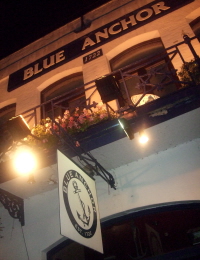 Blue Anchor, London W6 Traditional pub (Independent)
13 Lower Mall W6 9DJ
T (020) 8748 5774 W www.blueanchorlondon.com
Open 1200-2300 (2230 Sun). Children welcome until early evening.
Cask beers 4 (Nelson, 3 often unusual guests) Cask Marque, Other beers 2 keg, 3 bottles, Also Around 20 wines, a few malts
Food Enhanced pub grub, tapas, sharing plates, pies, Outdoor Riverside terrace, Wifi. Disabled toiliet.
Functions, quiz planned.
The handsome Blue Anchor enjoys one of the most splendid locations in London, right on the river just upstream of Hammersmith Bridge with an extensive terrace on the Thames Path: fans of classic 1970s TV comedy thriller Minder may recognise the bridge and the pub from the end credits. It first appears in written records in 1722 but may well date back much further, as the original village of Hammersmith was on the riverbank. It’s along the route of the Oxford and Cambridge boat race and also claims to be the place where composer Gustav Holst (1874-1934), who once lived in Barnes across the river and taught at St Paul’s Girls School in Hammersmith, stayed while working on the Hammersmith suite in 1930. It’s been much altered, and much of the old fashioned-looking interior with its sombre dark wood, perimeter shelves and rowing junk is relatiely recent, though the vintage disused beer engine visible through the front windows is genuine. The main bar is relatively small but there’s a compact and comfy lounge round the back and a room upstairs with panoramic river views.
Own-branded Blue Anchor ale from the Nelson brewery is the only regular cask beer; the remaining three pumps rotate a range of beers from small and often local producers such as Red Squirrel, Sambrook’s or Weltons. Staropramen and Pilsner Urquell are on keg and a scattering of bottled imports includes Budvar and Hoegaarden. The menu runs from nibbles via “Pie and a Pint” deals to steaks, at reasonable but not bargain basement prices: hickory smoked baby back ribs is a speciality and there’s a number of veggie options. It’s a short walk from another classic riverside pub, the Dove (p223).
Pub trivia. Blue Anchor is a relatively common pub name in places where navigation is or was an important local activity, blue being the traditional colour of hope.
Underground Ravenscourt Park, Hammersmith Cycling LCN+44, Putney, Fulham, link to NCN4 Walking Thames Path
London’s Best Beer, Pubs and Bars updates
Southwest London: Other locations — Putney
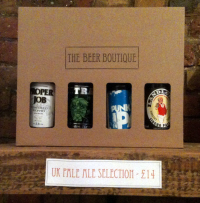 Beer Boutique SW15 Shop
134 Upper Richmond Road SW15 2SP
T (020) 8780 3168 W www.thebeerboutique.co.uk f The-Beer-Boutique tw thebeerboutique
Open 1100-2230 (2000 Sun-Mon).
Cask beers None, Other beers 130-140 bottles, Also 5 bottled ciders/perries, a few wines planned
Food None except tastings, though see review. Flat access.
Sat informal tastings with food matching.
It’s a reflection on London’s developing beer scene that the latest specialist beer shop isn’t a dusty cubby hole crammed with the sort of obscurities that crowd a beer geek’s wants list. Instead it’s a bold high street boutique in well-heeled Putney, aimed squarely at popularising fine beer among the sort of people who might not know their Chinook from their Challenger but recognise the value in artisanal products. Eddy Lancaster’s Beer Boutique, opened in August 2011, stocks no more than 140 beers, a fraction of what you’ll find at Kris Wines or Utobeer. For the most part they are solid classics and reliable newcomers that will be very familiar to the sort of people who tick their way through lists on ratebeer.com, but for someone new to craft beer they’ll do a great job of covering the beer world’s marvellously wide range of flavours and provide a firm grounding in zythological excellence. Staff give sound advice, and pleasingly they’re already converting curious passers-by into regulars.
The shop itself is stylish in an understated way, with lots of natural wood surfaces — very like a boutique wine shop, in fact, which I doubt is unintentional. The relatively limited stock doesn’t pack it to the ceiling so there’s plenty of room to mooch and browse, with a central table scattered with beer books for reference or sale. Beers are grouped by broad style: wheat beers, lagers, blond beers, hoppy pale ales, fruit beers and lambics, Trappists, British ales, brown and red beers (including dark lagers and wheats), and stouts and porters. Though rarely seen in the trade, this is a particularly useful system for the newcomer, making connections that cross national divides, so Schneider Aventinus might appear next to a strong, dark abbey ale, or Belgian and US saisons stand side by side. More beer shops should consider this kind of presentation rather than the traditional “countries and breweries” approach.
All the choices are thoughtful: a good range of Belgians including Troubadour, Abbaye des Rocs, Cantillon, Boon, Vicaris, Rodenbach and St Feuillien; six of the seven Trappists; St Georgen, Schneider and Jever among the Germans; a few Americans (nothing especially rare) and Czechs; Duyck Jenlain and St Sylvestre Trois Monts from France; and a top flight British selection that includes Dark Star, Windsor & Eton, Sambrook’s, Magic Rock, Oakham and Kernel. The rarest and most expensive beer I spotted was Orkney Dark Island Reserve at £21 for a 750ml bottle — everything else is reasonably priced. There are some helpful beginners’ four packs, a few glasses, and a refreshing absence of boring beers from exotic places. A welcome evangelical addition to the scene.
Insider tip. Informal Saturday tastings might be accompanied by samples of Trappist and other artisanal cheeses, but if you want more substantial food, they’ll point you to the posh pie and mash shop next door, Putney Pies, a sister business which draws on the Beer Boutique to add a few more diverting bottles to its own beer list than those it obtains through its arrangement with Greene King.
National Rail Putney Underground East Putney Cycling NCN4, LCN+ 3 37 38, link to CS8 Walking Thames Path
 The Banker, London EC4 London’s Best Beer, Pubs and Bars updates
Central London – City
Contemporary pub (Fuller’s)
2 Cousin Lane EC4R 3TE
T (020) 7283 5206 W www.fullers.co.uk
Open 1100-2130 Mon, 1100-2300 Tue-Fri, closed Sat-Sun. Children welcome daytimes.
Cask beer 5 (Fuller’s) Cask Marque, Other beer 5 keg, 5 bottles, Also wines
Food Sharing platters of pub grub & English tapas, Outdoor Riverside terrace, Disabled toilet
Functions, occasional big screen sport
Ingeniously shoehorned under the arches of Cannon Street rail bridge just before it launches itself across the river, this unusual and attractive Fuller’s house at the end of an intriguing alleyway is something of a find given the City’s general dearth of great pubs. It even boasts outdoor seating, a rarity in this part of town, in the form of a waterside terrace right next to a flight of steps down to the river at an ancient access point. It’s friendly enough despite being big and busy, and deservedly won a Visitor’s Award in the 2011 fancyapint.com Best London Pubs awards.
The big main space has high tables and plenty of standing room. Capacity is extended by a mezzanine floor and there’s an unexpected labyrinth of side rooms done out in more relaxing, loungey style. Regulars on cask are Discovery, ESB, Gales Seafarers and London Pride plus a seasonal or guest (low gravity “people’s beer” Mighty Atom on my visit) and there are some serious Fuller’s bottles too, including 1845, Bengal Lancer and the Brewer’s Reserve series. A selection of relatively common keg beers — Blue Moon, Früli, Litovel and the like — adds interest. Don’t come here for a meal for one — all the food is in the form of sharing platters, involving the likes of baked Camembert, pissaladière, pork and ham terrine, samosas, pies, skewers and the like, including vegetarian selections.
Insider tip. Turn right as you walk in to find a strip of seating overlooking the river, right under the bridge deck. It’s a light and airy contrast to the rather industrial main space, with its bare brickwork and lack of natural light.
National Rail, Underground Cannon Street Cycling CS7, NCN4, LCN+0 Walking Thames Path, Jubilee Greenway, Jubilee Walkway
|
Cask  This pioneering new book explains what makes cask beer so special, and explores its past, present and future. Order now from CAMRA Books. Read more here. This pioneering new book explains what makes cask beer so special, and explores its past, present and future. Order now from CAMRA Books. Read more here.
London’s Best Beer  The fully updated 3rd edition of my essential award-winning guide to London’s vibrant beer scene is available now from CAMRA Books. Read more here. The fully updated 3rd edition of my essential award-winning guide to London’s vibrant beer scene is available now from CAMRA Books. Read more here.
|














